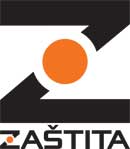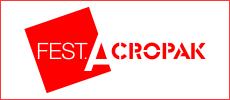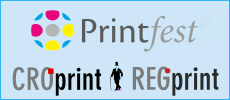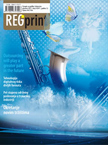«
Back to content
Vol 2 | Year 2017
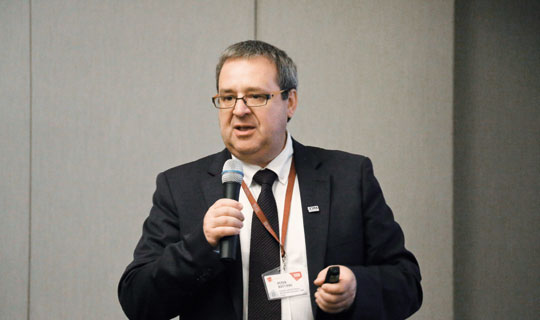
P. Buttiens: Printers, Go a Little Bit Outside Your Comfort Zone!
The sector of packaging labels grows rapidly, with almost 40% per year. The same holds true for the competitors of labels, sleeves, as well as folded carton and corrugated board – all areas which recognized the marketing advantage of high color printing and personalization.
ESMA is the European Specialist Printing Manufacturers Association which brings together suppliers, printers and technology consultants. Its objectives are to promote the adoption and correct use of various specialist printing processes through conferences, seminars, public relations, technical trainings and research into specific requirements of printing and imaging technologies especially for industrial applications. Mr. Peter Buttiens, CEO of ESMA was one of the speakers at this year’s festival of packaging in Zagreb. We took the opportunity of an interview with him regarding new trends in graphic arts industry.
Your association is committed to developing higher technical standards for specialist printing processes, and meeting European legal requirements for health, safety and environmental issues. Can you please introduce your organization little bit more?
ESMA was founded in 1990, so we are old enough to see the industry changing and grabbing new opportunities. Actually, we started purely as a trade organization for screen printing – an association of European manufacturers of screen printing equipment and consumables but over the years we have evolved into an association for industrial printing in general. I must say that industrial printing is a very broad term, it spreads among a lot of things. Today we are an organization that is involved in the manufacturing processes of cars, smartphones, tablets. We are everywhere where industrial printing is present, even in furniture, house appliances, airplanes… Besides, today we not only supply screen printing but also inkjet which reflects the growing importance of digital technologies for industrial applications.
In your last interview for our trade journal you said that one of your major goals was to ensure the future of screen printing in the face of the rise of digital inkjet technology in the large format area. Regarding the spreading of digital inkjet technology what are your goals now and what has been achieved?
In 2014 we have inaugurated TheIJC, The Inkjet Conference, which by now is an established platform for all forms of inkjet applications. As a matter of fact, TheIJC is the world’s biggest inkjet event, with 400 attendees last year and even higher expectations for 2017 (the conference will take place on 24-25 October 2017 in Swissotel Düsseldorf, Germany). As such we have provided the extremely dynamic inkjet community with a meeting place – for all OEMs, developers, engineers, chemists but also brand owners and academic researchers. TheIJC is a platform where the finest development companies, big players and aspiring start-ups initiate projects for all possible market applications, including packaging, textiles, interior decoration, ceramics, glass, plastics, printed electronics and others.
When we network with the industry during our conferences or when we follow their technology choices and their expansion to digital we notice a substantial need for highly skilled personnel. This is why this year we launched the ESMA Academy project. The first academy course took place in July 2017, was offered in German language and organized at the laboratories of Fraunhofer Institute for Manufacturing and Automation. It provided an overview of inkjet technologies, especially piezo inkjet, to all who plan or had just made the step towards digital. Split in five blocks, the theory part was covered printheads, characteristics of inks, substrates, pre-treatment and color management, as well as the build-up of entire printing systems and an overview of other digital printing techniques. Our goal was to offer a balanced program with both theoretical approach and real physical learning at the machine. The academy is for everyone involved in development, to those who want to understand the technology and integrate certain programs. Upcoming ESMA Academy events will include trainings in other European countries on topics such as digital textile printing, printed electronics and packaging.
In Croatia it is very hard to find workers in the industry and there’s a strong believe that it’s necessary to have more education for this segment of industry. Do you agree?
It is not a problem which is limited to Croatia, it is a global challenge. And it’s not only in large format printing, we notice it in textile and many more disciplines and actually we can see that in schools there are less and less students choosing for printing majors. Besides, applying traditional graphical education to things that are happening in the graphic arts sector today, seems almost like learning about something that happened in medieval times and not about the current trends and processes from the 21 century.
What was not in common use just five years ago, has become a standard today. I would almost compare it with the car industry. If you look at the cars five years ago, if you look at the printing machines five years ago, it’s the same thing – changes are just huge. And, let’s just say one more thing – applications are much more than just decoration.
What do you think is the main reason why universities don’t follow trends and changes that are happening in the market?
It looks like the market changes occur too rapidly for the universities to respond with an appropriate curriculum and so far the newest technologies are a subject of many scientific projects but still not a part of the teaching process.
Who can become ESMA member, what conditions must be fulfilled? What are the main benefits you have to offer to your members?
We’re now just above 70 members and that number is fluctuating, but we’re still growing. We have more and more members from the entire supply chain of printing as part of the manufacturing process. What is really necessary to be a member is to be an Europe-based company with affiliation to specialist, industrial or functional printing processes. There are two levels of membership. The first are voting members who are original supplies manufacturers. These can be machine manufacturers, pre- and post-processing, software, suppliers of inks and other components for screen and digital print processes. The second group are non-voting members and technology partners. Technology partners must be involved with printing technology – this could be development, support, distribution, sales, training, consultancy or users.
By becoming an ESMA member, you enter a tight community which represents this specific industry on all major European and global exhibitions. Over the years we have developed a special relationship with Messe Düsseldorf and by now we are the PEPSO (Printed Electronics Products and Solutions) partner for seven different shows. Apart from that, we promote specialist printing processes through our own conferences, as well as various communication channels, newsletters, publications, social media. Priority is given to members to speak at the conferences and now to be involved in the ESMA Academy.
One of the recent projects is the ESMA Expert Team consisting of representatives from our member companies. The experts support ESMA during the major industry shows. In general, we’re always there to help the industry on different markets.
Another aspect which is frequently mentioned by our members as a tangible membership benefit are the working committees which meet twice a year around topics such as technical exchange, marketing and promotion, health, safety and environmental protection.
One of your tasks is lobbying at Brussels for regulations and legislation. Can you tell us some more about the regulations you want to be adopted?
The above mentioned committee on health, safety and environmental protection looks closely at all REACH, GHS, CLP and other EU and global regulations. We work together with other organizations to lobby together for changes. We advise our members, but we also lobby at European DG’s and agencies to encourage changes or different approach to specific printing inks. As a matter of fact, there are ESMA members who have joined the association because of the value they recognized in the HSEP committee. One of the biggest challenges is the constant update of the exemption lists of chemicals. The ecology factor is becoming more and more important, as well as the committee’s research into nanomaterial registries.
What was the impact of financial crisis on print industry? Which parts of printing industry suffered the most and is the market recovering now?
The biggest impact was in commercial print where we were not so much inside.
Automotive and glass sector were heavily confronted. There is a global shift to new market segments which are less graphic and more industrial oriented. So, industrial printing will survive by adaption. I can tell you that it will come out even stronger. Actually, printing industry grew after the recession. We had a minimum number of companies from the specialist printing industry that haven’t survived the recession period, I think less than 1 %. Although I see more and more investments, we still have to be careful, we have to watch out. On the large graphic market there are less and less small players and more and more big ones which have become very active in the web-to-print sector.
Some analyses show that the future of graphic arts industry is in packaging print. What is your opinion about that?
The sector of packaging labels grows rapidly, with almost 40 % per year. The same holds true for the competitors of labels, sleeves, as well as folded carton and corrugated board – all areas which recognized the marketing advantage of high color printing and personalization. But we also feel that there’s a very big demand for plastics, aluminum and glass print in packaging materials. In the last 10 to 15 years the cost of production of these materials has lowered, they have become lighter and recyclable.
Very often plastics can’t be reused, but they are being reused as something else. We see a complete boost in packaging. Today packaging is becoming the new advertisement for product sales. Earlier, yoghurt pots were just a yoghurt pots, today they need to look special and tell you a story, it is like you’re wise because you eat yogurt. Packaging is telling a story today and as such it brings new opportunities.
Packaging is a very conservative market, but at the certain time we have to put the conservatism aside to be ready for the next generation of consumers. If you ask Generation Y, they will surely answer they want to see something different. Health is for instance very important today, so messages on the packaging have to be about health – how to prepare your food, what can you do with it and why is this good for your health. It will advise you maybe to do certain exercises. Packaging is becoming more like a message board.
What is your best advice to the printing industry? How can they transform businesses to stay profitable and competitive?
I would definitely advise them to use the expression “Think outside of the box” in their business or to go a little bit outside of their comfort zone. Selling traditional items is not good enough anymore, so why not try to go more and more into textiles, interior decoration, enter into cooperation with shop fitters, hotel fitters, restaurants, everywhere where you someone wants to give a right and distinctive message. Another thing is to keep your eyes open to see what is in your own interest, where you believe you have the possibilities to join new segments in printing industry. I don’t say that everyone has to make a step into industrial applications but even the decorative applications can grow into something interesting.
The last exciting point is cross media. Try to combine printing with online to collect data. The world of printing needs to go interactive in the right sense of the word. That interaction is between the brand and potential customers, and second we have to invest in online technology. The main word is here specialization on all levels. Printing is only one part, but the whole handling, shipping of finished products needs to be perfected through the whole workflow until it is delivered to the customer.
Specialization in new segments is one part, but knowing the market, the customers and the real ins and outs of that business environment is the key.
Interview by: Nataša Gajski Kovačić
Your association is committed to developing higher technical standards for specialist printing processes, and meeting European legal requirements for health, safety and environmental issues. Can you please introduce your organization little bit more?
ESMA was founded in 1990, so we are old enough to see the industry changing and grabbing new opportunities. Actually, we started purely as a trade organization for screen printing – an association of European manufacturers of screen printing equipment and consumables but over the years we have evolved into an association for industrial printing in general. I must say that industrial printing is a very broad term, it spreads among a lot of things. Today we are an organization that is involved in the manufacturing processes of cars, smartphones, tablets. We are everywhere where industrial printing is present, even in furniture, house appliances, airplanes… Besides, today we not only supply screen printing but also inkjet which reflects the growing importance of digital technologies for industrial applications.
In your last interview for our trade journal you said that one of your major goals was to ensure the future of screen printing in the face of the rise of digital inkjet technology in the large format area. Regarding the spreading of digital inkjet technology what are your goals now and what has been achieved?
In 2014 we have inaugurated TheIJC, The Inkjet Conference, which by now is an established platform for all forms of inkjet applications. As a matter of fact, TheIJC is the world’s biggest inkjet event, with 400 attendees last year and even higher expectations for 2017 (the conference will take place on 24-25 October 2017 in Swissotel Düsseldorf, Germany). As such we have provided the extremely dynamic inkjet community with a meeting place – for all OEMs, developers, engineers, chemists but also brand owners and academic researchers. TheIJC is a platform where the finest development companies, big players and aspiring start-ups initiate projects for all possible market applications, including packaging, textiles, interior decoration, ceramics, glass, plastics, printed electronics and others.
When we network with the industry during our conferences or when we follow their technology choices and their expansion to digital we notice a substantial need for highly skilled personnel. This is why this year we launched the ESMA Academy project. The first academy course took place in July 2017, was offered in German language and organized at the laboratories of Fraunhofer Institute for Manufacturing and Automation. It provided an overview of inkjet technologies, especially piezo inkjet, to all who plan or had just made the step towards digital. Split in five blocks, the theory part was covered printheads, characteristics of inks, substrates, pre-treatment and color management, as well as the build-up of entire printing systems and an overview of other digital printing techniques. Our goal was to offer a balanced program with both theoretical approach and real physical learning at the machine. The academy is for everyone involved in development, to those who want to understand the technology and integrate certain programs. Upcoming ESMA Academy events will include trainings in other European countries on topics such as digital textile printing, printed electronics and packaging.
In Croatia it is very hard to find workers in the industry and there’s a strong believe that it’s necessary to have more education for this segment of industry. Do you agree?
It is not a problem which is limited to Croatia, it is a global challenge. And it’s not only in large format printing, we notice it in textile and many more disciplines and actually we can see that in schools there are less and less students choosing for printing majors. Besides, applying traditional graphical education to things that are happening in the graphic arts sector today, seems almost like learning about something that happened in medieval times and not about the current trends and processes from the 21 century.
What was not in common use just five years ago, has become a standard today. I would almost compare it with the car industry. If you look at the cars five years ago, if you look at the printing machines five years ago, it’s the same thing – changes are just huge. And, let’s just say one more thing – applications are much more than just decoration.
What do you think is the main reason why universities don’t follow trends and changes that are happening in the market?
It looks like the market changes occur too rapidly for the universities to respond with an appropriate curriculum and so far the newest technologies are a subject of many scientific projects but still not a part of the teaching process.
Who can become ESMA member, what conditions must be fulfilled? What are the main benefits you have to offer to your members?
We’re now just above 70 members and that number is fluctuating, but we’re still growing. We have more and more members from the entire supply chain of printing as part of the manufacturing process. What is really necessary to be a member is to be an Europe-based company with affiliation to specialist, industrial or functional printing processes. There are two levels of membership. The first are voting members who are original supplies manufacturers. These can be machine manufacturers, pre- and post-processing, software, suppliers of inks and other components for screen and digital print processes. The second group are non-voting members and technology partners. Technology partners must be involved with printing technology – this could be development, support, distribution, sales, training, consultancy or users.
By becoming an ESMA member, you enter a tight community which represents this specific industry on all major European and global exhibitions. Over the years we have developed a special relationship with Messe Düsseldorf and by now we are the PEPSO (Printed Electronics Products and Solutions) partner for seven different shows. Apart from that, we promote specialist printing processes through our own conferences, as well as various communication channels, newsletters, publications, social media. Priority is given to members to speak at the conferences and now to be involved in the ESMA Academy.
One of the recent projects is the ESMA Expert Team consisting of representatives from our member companies. The experts support ESMA during the major industry shows. In general, we’re always there to help the industry on different markets.
Another aspect which is frequently mentioned by our members as a tangible membership benefit are the working committees which meet twice a year around topics such as technical exchange, marketing and promotion, health, safety and environmental protection.
One of your tasks is lobbying at Brussels for regulations and legislation. Can you tell us some more about the regulations you want to be adopted?
The above mentioned committee on health, safety and environmental protection looks closely at all REACH, GHS, CLP and other EU and global regulations. We work together with other organizations to lobby together for changes. We advise our members, but we also lobby at European DG’s and agencies to encourage changes or different approach to specific printing inks. As a matter of fact, there are ESMA members who have joined the association because of the value they recognized in the HSEP committee. One of the biggest challenges is the constant update of the exemption lists of chemicals. The ecology factor is becoming more and more important, as well as the committee’s research into nanomaterial registries.
What was the impact of financial crisis on print industry? Which parts of printing industry suffered the most and is the market recovering now?
The biggest impact was in commercial print where we were not so much inside.
Automotive and glass sector were heavily confronted. There is a global shift to new market segments which are less graphic and more industrial oriented. So, industrial printing will survive by adaption. I can tell you that it will come out even stronger. Actually, printing industry grew after the recession. We had a minimum number of companies from the specialist printing industry that haven’t survived the recession period, I think less than 1 %. Although I see more and more investments, we still have to be careful, we have to watch out. On the large graphic market there are less and less small players and more and more big ones which have become very active in the web-to-print sector.
Some analyses show that the future of graphic arts industry is in packaging print. What is your opinion about that?
The sector of packaging labels grows rapidly, with almost 40 % per year. The same holds true for the competitors of labels, sleeves, as well as folded carton and corrugated board – all areas which recognized the marketing advantage of high color printing and personalization. But we also feel that there’s a very big demand for plastics, aluminum and glass print in packaging materials. In the last 10 to 15 years the cost of production of these materials has lowered, they have become lighter and recyclable.
Very often plastics can’t be reused, but they are being reused as something else. We see a complete boost in packaging. Today packaging is becoming the new advertisement for product sales. Earlier, yoghurt pots were just a yoghurt pots, today they need to look special and tell you a story, it is like you’re wise because you eat yogurt. Packaging is telling a story today and as such it brings new opportunities.
Packaging is a very conservative market, but at the certain time we have to put the conservatism aside to be ready for the next generation of consumers. If you ask Generation Y, they will surely answer they want to see something different. Health is for instance very important today, so messages on the packaging have to be about health – how to prepare your food, what can you do with it and why is this good for your health. It will advise you maybe to do certain exercises. Packaging is becoming more like a message board.
What is your best advice to the printing industry? How can they transform businesses to stay profitable and competitive?
I would definitely advise them to use the expression “Think outside of the box” in their business or to go a little bit outside of their comfort zone. Selling traditional items is not good enough anymore, so why not try to go more and more into textiles, interior decoration, enter into cooperation with shop fitters, hotel fitters, restaurants, everywhere where you someone wants to give a right and distinctive message. Another thing is to keep your eyes open to see what is in your own interest, where you believe you have the possibilities to join new segments in printing industry. I don’t say that everyone has to make a step into industrial applications but even the decorative applications can grow into something interesting.
The last exciting point is cross media. Try to combine printing with online to collect data. The world of printing needs to go interactive in the right sense of the word. That interaction is between the brand and potential customers, and second we have to invest in online technology. The main word is here specialization on all levels. Printing is only one part, but the whole handling, shipping of finished products needs to be perfected through the whole workflow until it is delivered to the customer.
Specialization in new segments is one part, but knowing the market, the customers and the real ins and outs of that business environment is the key.
Interview by: Nataša Gajski Kovačić







